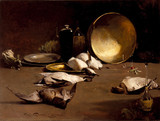At the turn of the century Soren Emil Carlsen was considered among the country’s foremost still-life painters. After studying architecture in Denmark, Carlsen emigrated to the United States in 1872, settling in Chicago, where he began to paint and to teach at the Art Institute. In 1875 he returned to Europe to study painting in Parts. For most of the next decade he lived in New York, supporting himself with teaching and other work as he gradually attained a reputation as a still-life painter. From 1884 to 1886 he worked in Paris, commissioned by an art dealer to paint still-life canvases. During this period he became known for his floral still lifes, especially of yellow roses. He lived in San Francisco from 1887 to 1891 and for two years was director of the School of Design of the San Francisco Art Association. He then moved permanently to New York, teaching at both the National Academy of Design and Pennsylvania Academy of the Fine Arts, Philadelphia. He married in 1896; his son Dines (1901-1966) was also an artist. His greatest success came shortly before the turn of the century and during the first two decades of this century, when he achieved fame for both his still lifes and his landscapes. His mature still lifes included both Chardinesque subjects and arrangements of oriental porcelains.
BIBLIOGRAPHY
California Art Research 4 (January 1937): 27-63, with lists of representative works, collections, and prizes, bibliography § Tyler (Tex.) Museum of Art, Emil Carlsen, exh. cat., 1973, with introduction by Meredith Long § San Francisco, Wortsman Rowe Galleries, and others, The Art of Emil Carlsen, 1853-1932, exh. cat., 1975, with reprints of early (1902-21) essays by Duncan Phillips, Eliot Clark, Arthur Edwin Bye, and others, lists of public collections and awards § New York, Hammer Galleries, The Art of Emil Carlsen, exh. cat., 1977, with essay by Dorothy Tananbaum, list of public collections § Jeffrey Stewart, "Soren Emil Carlsen," in Plein Air Painters of California: The North, ed. Ruth Lilly Westphal (Irvine, Calif: Westphal Publishing, 1986): 52-57, with lists of studio locations, organizations, awards, and public collections.
